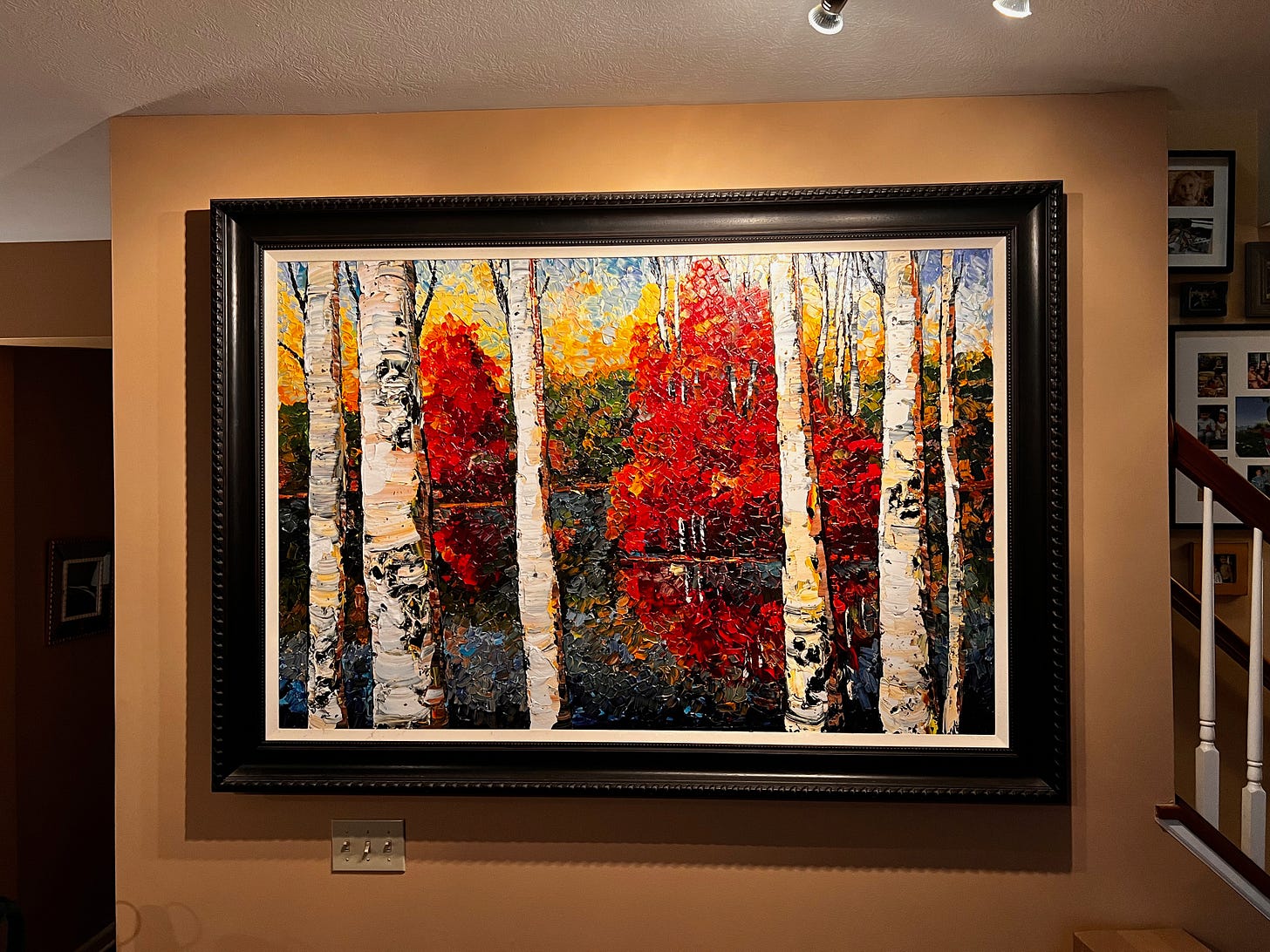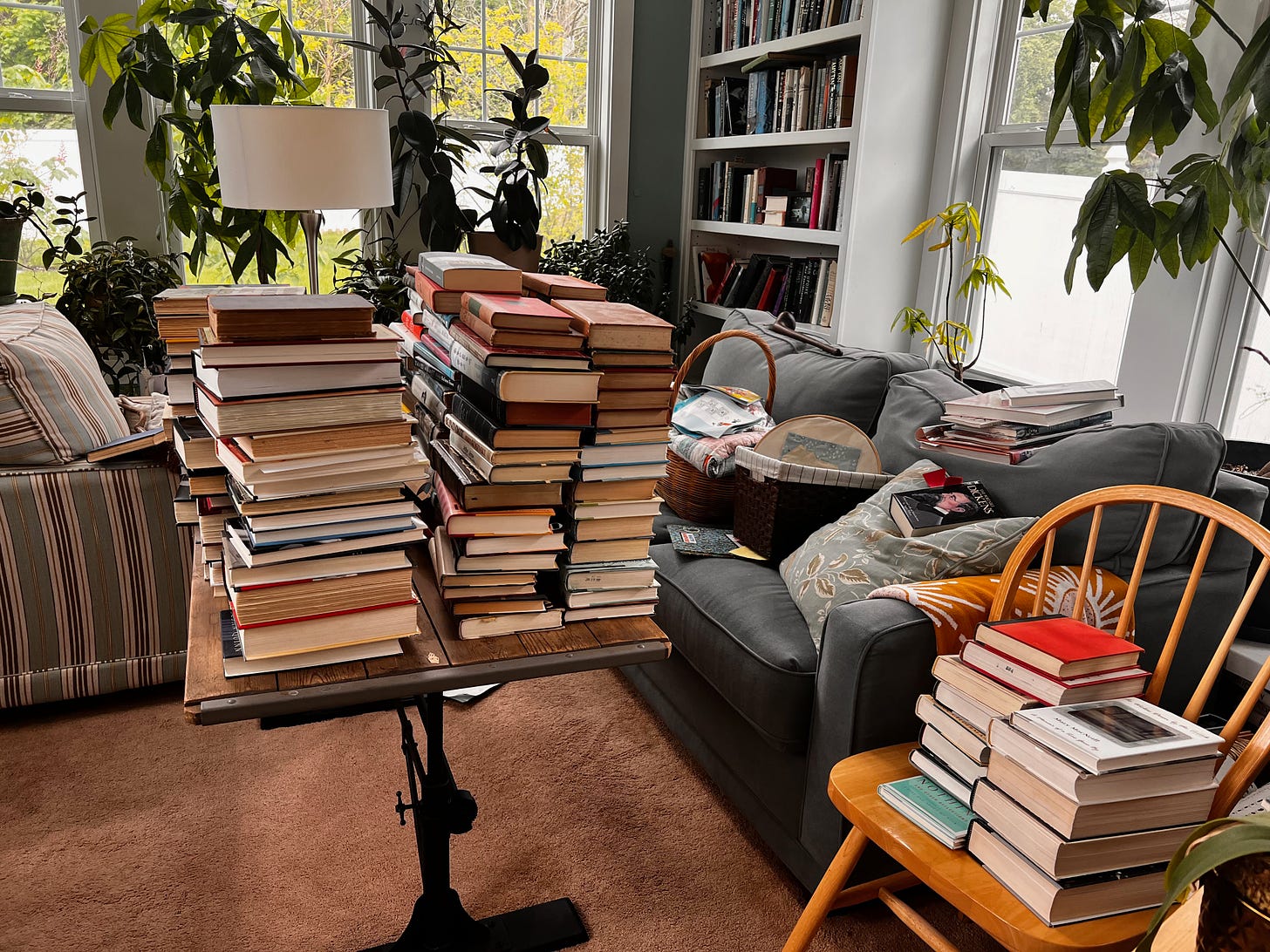One of the good things about undertaking a house move is its ability to focus the mind. So many tasks to complete as the clock ticks, ticks, ticks. I’m not less aware of all that is happening in our country right now. I just have a fresh way to expend some of that churning outrage.
One of the worst things about moving, however, is its tendency to make anything other than packing, donating and trashing feel frivolous. This is treacherous terrain for a writer. In my case, it has been nearly paralyzing.
Currently, I have four Substack essays brewing on my desktop. Each idea began strong but halfway through stopped gurgling, much like our drip coffeemaker after a fuse blew in our new, very old home. (We are far from moved in, but we installed the coffeemaker in the kitchen within days of receiving the keys.)
I have trained myself to take breaks from sitting too long, for health reasons buttressed by vanity. I would like the headline of my obituary not to read, She Died From Sitting. These days, each stretch of the legs launches another tour through towers of boxes in the land of all that is yet to done. I have been falling prey to the writer’s monster, the one I’ve been fighting all my adult life. Who are you to prioritize writing, the monster growls, when there is so much else to be done?
To give in to the monster is to lose hold of who I am. More to the point, when I am not writing I become irritable and unsettled, as if I’m looking for something I need but cannot find.
That tea pot in the first photo? For years, it has sat on my writing desk as a constant reminder—a protest, really--that the dishes, and every other inch of housework, can wait. One of the biggest obstacles for many women who write—for this woman who writes, anyway--is the mound of domestic responsibility too often blocking the view of the words trying to find us. After forty years as a writer, I can still sit at the keyboard and easily talk myself into feeling like a slug of a wife, mother, friend. Nobody is suggesting I feel this guilt. I volunteer to carry it, like a trained mule.
When my children were young and I was freelancing, I regularly awakened at 3 a.m. to write for three hours before the house came to life. It was a hard habit to break. Long after they were grown, I still awakened at the witching hour. It was only after I fell in love with Sherrod, at age 45, that my insomnia lifted. He loves reminding me of this. I’ve asked him to avoid mentioning it in speeches, but the concept of too much information eludes him.
Which brings me to why I’m able to finish this essay, and several more to come. I had vowed not to write much about this big move of ours, but it is the headline of my life right now. So, here we are.
On many a news-grinding day, I have welcomed the distraction of this move. It’s easy to surrender to it because I know all of this will soon come to an end. We have a solid move-in date, and while we have hired a wonderful organizer to help this time, all the big decisions remain firmly embedded in us, like the talons of a hawk on our shoulders. I am grateful for the items that require no mulling, and no guilt.
Which brings me to this painting by Russian Canadian artist Maya Eventov. I fell in love with it in early 2011, certain that I could never own it.

The painting was enormous: Nearly six feet wide and four feet high. We had only one wall large enough to hold it, maybe, over the fireplace in the “great room,” which is what builders call a room that is about as cozy as an amphitheater. Also, the cost of the painting was way over budget, by my calculations. An upscale consignment shop in Columbus, Ohio, was selling it, and with every passing week it didn’t sell, the painting’s price would go down a bit until it hit the limit. Even at its lowest, I couldn’t imagine spending that kind of money on myself.
So, for months I just visited Eventov’s painting. Sometimes in person, often online at the shop’s website. She had painted a canvas of birch trees on the banks of a river in the peak of autumn, my favorite season. Close up, it feels sculpted under the soft touch of fingers—impasto, I’ve learned this technique is called—and summons many memories of favorite trees from my childhood.
Just once, I brought Sherrod along on my visit to see the painting. Not because I thought he might buy it. I knew better, as our tastes in art differ widely. I just wanted him to take in the view that so often calmed the pounding of my heart and encouraged me to breathe.
For months, I visited the painting. And then one day, in late autumn, the painting was gone. I sat at the kitchen table, signed onto the shop’s website and gasped. “Oh, no,” I said, in what I thought was a whisper.
Sherrod was sitting on the sofa. “What’s wrong?”
“Nothing, nothing,” I said. “It’s just the painting. Somebody bought it.”
He walked up behind me and squeezed my shoulders. “Sorry, honey. I know you loved it.”
You know where this is going. I had no idea of course, as I seldom do when it comes to Sherrod’s schemes to surprise. On Christmas morning we had a full house of adult children and one grandchild, Clayton. After we had unwrapped all the gifts, I announced I was going upstairs to take a shower before I started cooking.
A half-hour later, I headed back down and was greeted by Sherrod and son-in-law Matt, grinning at the foot of the stairs as they held up that giant painting. I sat on the fourth step from the bottom and burst into tears.
In recent weeks, Sherrod has told that story many times, to every stranger entering this house to help with our move, and everyone helping with painting and renovations at our new house. He tells them about how sad I was when the painting was sold. He boasts about how he and a friend carted the painting wrapped in blankets in a borrowed truck. He describes how, in the same moment he introduced himself to our new neighbors, he asked them to hide the painting in their garage until Christmas day. (Bless you, Kirk and Pat.) He talks about the artist, too, and how we hope one day to meet her in Toronto, where she lives and paints. (We love you, Canada.)
We moved in 2013, and for twelve years this painting has hung on the only wall that could hold it. The display lights were already there, just waiting for it. That’s how I knew it was the new home for us.
After the election, we decided to move closer to grandchildren. I had a short list of requirements. I wanted a window over the kitchen sink, air conditioning for my asthmatic lungs, and a wall big enough to hold our view of those birch trees.
It will hang in our living room, on the wall between our moss-green, vintage sofas. Our ceilings are lower in this house, and so this time our young grandchildren will stand in front of the painting as if they were looking out a large window. My idea of a great room.
Yes, you can touch it, I will tell them. Gently, and only after you wash your hands.
Grandpa will tell them the story. Most of them know it by now, but there is something about the gleam in his eyes whenever he says, “Once upon a time, your grandma fell in love with a painting.”
“And then what happened, Grandpa?” the youngest will ask.







What a beautiful slice of your life! That painting is gorgeous.
You wove into this essay the subtle and not so subtle concerns of so many women. Investing in ourselves, whether for creativity purposes, how we spend our time or what we spend money seems to be a struggle for many. Thanks as always for your writing which often produces a lump in my throat.
Our two kids, boy/girl twins, who are now finishing their junior year in high school, were born two months early. So their first 4-5 weeks of existence were spent at the wonderful Magee Women's Hospital here in Pittsburgh, in the neonatal intensive care unit. Neither of them were five pounds when they were born, and in fact our daughter Renee dipped from three pounds, seven ounces to nearly three pounds a couple days after she was born, though we were told all babies tend to lose a bit of weight in the first days. None of this is evident today, so my wife and I must have done some things right. Anyway, this meant that we would travel back and forth to the NICU every day before finally being able to bring them home, and there was a painting in one of the lobbies at Magee that my wife really enjoyed. I haven't thought about that painting in nearly 17 years, but I did today, thanks to you, Connie. It was of a lone iceberg in the middle of a colorful sea. I must explore whether it is still there, and perhaps, even available for purchase, as our 20th wedding anniversary will be here soon.